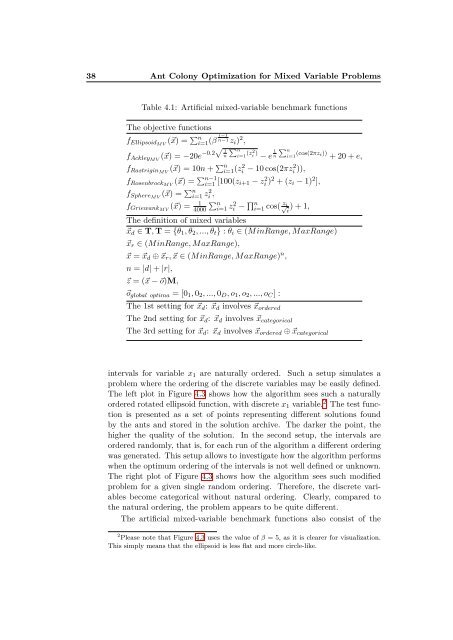Improved ant colony optimization algorithms for continuous ... - CoDE
Improved ant colony optimization algorithms for continuous ... - CoDE
Improved ant colony optimization algorithms for continuous ... - CoDE
You also want an ePaper? Increase the reach of your titles
YUMPU automatically turns print PDFs into web optimized ePapers that Google loves.
38 Ant Colony Optimization <strong>for</strong> Mixed Variable Problems<br />
Table 4.1: Artificial mixed-variable benchmark functions<br />
The objective functions<br />
fEllipsoidMV (x) = n i=1 (β i−1<br />
n−1 zi) 2 ,<br />
fAckleyMV (x) = −20e−0.2 1<br />
n<br />
n<br />
i=1 (z2 i ) − e 1<br />
n<br />
fRastriginMV (x) = 10n + n i=1 (z 2 i − 10 cos(2πz2 i )),<br />
n<br />
i=1 (cos(2πzi)) + 20 + e,<br />
fRosenbrockMV (x) = n−1<br />
i=1 [100(zi+1 − z 2 i )2 + (zi − 1) 2 ],<br />
fSphereMV (x) = n i=1 z 2 i ,<br />
fGriewankMV<br />
(x) = 1<br />
4000<br />
ni=1 z2 i − n i=1 cos( zi √ ) + 1,<br />
i<br />
The definition of mixed variables<br />
xd ∈ T, T = {θ1, θ2, ..., θt} : θi ∈ (MinRange, MaxRange)<br />
xr ∈ (MinRange, MaxRange),<br />
x = xd ⊕ xr, x ∈ (MinRange, MaxRange) n ,<br />
n = |d| + |r|,<br />
z = (x − o)M,<br />
oglobal optima = [01, 02, ..., 0D, o1, o2, ..., oC] :<br />
The 1st setting <strong>for</strong> xd: xd involves xordered<br />
The 2nd setting <strong>for</strong> xd: xd involves xcategorical<br />
The 3rd setting <strong>for</strong> xd: xd involves xordered ⊕ xcategorical<br />
intervals <strong>for</strong> variable x1 are naturally ordered. Such a setup simulates a<br />
problem where the ordering of the discrete variables may be easily defined.<br />
The left plot in Figure 4.3 shows how the algorithm sees such a naturally<br />
ordered rotated ellipsoid function, with discrete x1 variable. 2 The test function<br />
is presented as a set of points representing different solutions found<br />
by the <strong>ant</strong>s and stored in the solution archive. The darker the point, the<br />
higher the quality of the solution. In the second setup, the intervals are<br />
ordered randomly, that is, <strong>for</strong> each run of the algorithm a different ordering<br />
was generated. This setup allows to investigate how the algorithm per<strong>for</strong>ms<br />
when the optimum ordering of the intervals is not well defined or unknown.<br />
The right plot of Figure 4.3 shows how the algorithm sees such modified<br />
problem <strong>for</strong> a given single random ordering. There<strong>for</strong>e, the discrete variables<br />
become categorical without natural ordering. Clearly, compared to<br />
the natural ordering, the problem appears to be quite different.<br />
The artificial mixed-variable benchmark functions also consist of the<br />
2 Please note that Figure 4.3 uses the value of β = 5, as it is clearer <strong>for</strong> visualization.<br />
This simply means that the ellipsoid is less flat and more circle-like.

















